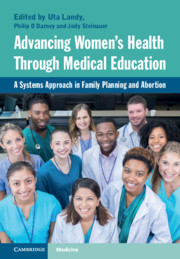 Advancing Women's Health Through Medical Education
Advancing Women's Health Through Medical Education Book contents
- Advancing Women’s Health Through Medical Education
- Reviews
- Advancing Women’s Health Through Medical Education
- Copyright page
- Dedication
- Contents
- Contributors
- Preface
- Acknowledgments
- Introduction
- Section I Abortion Training: Workforce, Leadership, Social & Political Impact
- Section II Integration of Abortion into Graduate Medical Education
- Chapter 9 Abortion Training in the USA
- Chapter 10 Starting and Optimizing an Academic Abortion Service
- Chapter 11 The Role of Early Pregnancy Loss Care in Ensuring Competence in Uterine Evacuation
- Chapter 12 Academic Family Planning and Sexual and Reproductive Health Collaborations
- Chapter 13 Family Planning Training at Catholic and Other Faith-Based Hospitals
- Chapter 14 The Importance of Including Abortion in Undergraduate Medical Education
- Chapter 15 Integrating Sexual and Reproductive Health-Care Training into Family Medicine
- Chapter 16 Integrating Abortion Training into Advanced-Practice Clinician Programs
- Section III Family Planning Curricular Design & Implementation
- Section IV Reproductive Health Services & Abortion Training: Global Examples
- Index
- References
Chapter 10 - Starting and Optimizing an Academic Abortion Service
from Section II - Integration of Abortion into Graduate Medical Education
Published online by Cambridge University Press: 30 July 2021
- Advancing Women’s Health Through Medical Education
- Reviews
- Advancing Women’s Health Through Medical Education
- Copyright page
- Dedication
- Contents
- Contributors
- Preface
- Acknowledgments
- Introduction
- Section I Abortion Training: Workforce, Leadership, Social & Political Impact
- Section II Integration of Abortion into Graduate Medical Education
- Chapter 9 Abortion Training in the USA
- Chapter 10 Starting and Optimizing an Academic Abortion Service
- Chapter 11 The Role of Early Pregnancy Loss Care in Ensuring Competence in Uterine Evacuation
- Chapter 12 Academic Family Planning and Sexual and Reproductive Health Collaborations
- Chapter 13 Family Planning Training at Catholic and Other Faith-Based Hospitals
- Chapter 14 The Importance of Including Abortion in Undergraduate Medical Education
- Chapter 15 Integrating Sexual and Reproductive Health-Care Training into Family Medicine
- Chapter 16 Integrating Abortion Training into Advanced-Practice Clinician Programs
- Section III Family Planning Curricular Design & Implementation
- Section IV Reproductive Health Services & Abortion Training: Global Examples
- Index
- References
Summary
Abortion is generally a simple, safe procedure; providing it in a general academic obgyn setting poses unique opportunities and challenges for patients, providers and learners. This chapter reviews options and considerations and provides resources for starting and improving a teaching abortion service, including guidelines, patient education, and important relationships to consider. The family planning teaching services at UCSF and UCSF’s Zuckerberg San Francisco General Hospital are presented as two different service and teaching examples. Abortion services can raise challenges with policies, insurance, scheduling, clinic safety and staff refusals to take care of patients. Patients face their own challenges to seek care, such as stigma, travel, poverty, and intense emotions, and many have experienced domestic violence and sexual assault. Residents and students need to address their personal emotions in addition to learning clinical skills. Providing patient-centered abortion services, particularly for patients who cannot be seen elsewhere, is an issue of equity that makes it highly valuable learning opportunity.
Keywords
- Type
- Chapter
- Information
- Advancing Women's Health Through Medical EducationA Systems Approach in Family Planning and Abortion, pp. 110 - 122Publisher: Cambridge University PressPrint publication year: 2021
